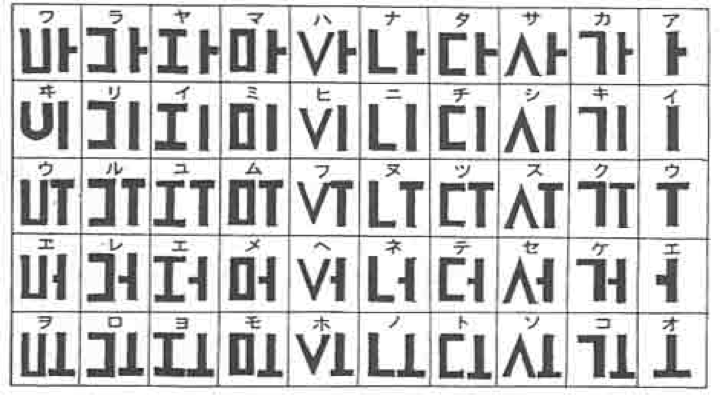Writing from the Age of the Gods
« previous post | next post »
[This is a guest post by Bob Ramsey]

Writing from the Age of the Gods (Jindai moji)
Writing was a problematic issue for Japanese nationalists.
Why is all Japanese writing derived from Chinese characters, many wondered. Why did we Japanese not invent writing ourselves? Why, they asked, were we not already writing with our own letters when Chinese characters reached our shores?
During the Tokugawa period, these questions haunted nativists. If, as they fervently believed, the Japanese people were by nature superior to the crafty Chinese, well then, how could Japanese have been reduced to borrowing something so important from the Chinese?
These frustrated nativists had noticed something that piqued their interest, though. In the 13th-century, a historian named Urabe Kanekata had written of an ancient Japanese writing system that had been a gift from the gods. He wrote: “The masters of old have taught us that Chinese characters reached our kingdom during the reign of the Emperor Ōjin (r. 270-310 [trad.]); [but] the origin of Japanese letters was [far earlier] in the age of the gods…”
A script like that was just what the nativists longed for. But…where were those sacred Japanese letters now?
With what could only be called religious passion, Japanese nativists and nationalists searched the archives of temples and shrines for the holy letters, and, in the end, they “discovered” at least a dozen varieties of exotic writing presumed to be in indigenous Japanese scripts.
One of them is shown in the above photograph.
The result was that these jindai moji were taught during the height of Japan's nationalism before World War II and cited in Japanese scholarly books on the history of writing. Some “patriots” even had them inscribed on their tombstones!
Of course, all of these ‘ancient Japanese letters’ were complete fakes, and provably so, since the language they transcribed did not have the structure of Old Japanese at all, but rather that of the modern language. Today, whenever jindai moji are mentioned, their fake origins are usually pointed out.
And yet, there remains a particularly bitter irony in nationalists’ use of these writings to prove Japanese superiority. That’s because many, perhaps even most, of the so-called ‘Characters from the Age of the Gods’ were in fact copies of Korean writing—including those seen in the photograph, above. This particular chart of sacred letters is actually nothing more than an attempted pronunciation guide for Hangul letters!
ycx said,
May 26, 2021 @ 11:46 am
Apotheosis of Sejong confirmed!
J.W. Brewer said,
May 26, 2021 @ 1:31 pm
The mistake of the nationalists seems to have been to concede the validity of the unexamined premise that a writing system was a mark of civilization rather than a symptom of decadence.
Chas Belov said,
May 26, 2021 @ 3:18 pm
Where do the Vs and Ts (right-side up and upside-down) come from. Those are not part of hangul, so far as I know (as a low-functioning hangul reader).
Svafa said,
May 26, 2021 @ 3:52 pm
@Chas: ㅜ is u in hangul, so that's where the T comes from. I'm not sure on the V though. ㅎ is the h, so you'd expect that for the ハ column. But, the last three columns don't match hangul either, so it may just be completely made up, or an attempt at simplifying the appearance of hangul.
Svafa said,
May 26, 2021 @ 3:57 pm
[Continued] Sorry for two posts, I completely forgot the "(right-side up and upside-down)" portion and only pointed to one of each. ㅗ is o in hangul, so that checks out, and ㅅ is s, so the Ʌ kind of fits even if it's not quite accurate.
Jim Unger said,
May 26, 2021 @ 4:08 pm
I recall that the kokugaku-sha Hirata Atsutane is associated with this particular variety of jindai-moji. Of course, it is just linearized Korean hankul with some peculiar nonce initials thrown in. Interestingly, it seems that a number of Edo period scholars called out this stuff as a fraud—it didn't take Westerners to bring it to the attention of Japanese skeptics.
Victor Mair said,
May 26, 2021 @ 4:12 pm
@J. W. Brewer
Bingo!
See "The stupendous powers of memorization in the Indian tradition" (10/23/20), the posts in the "Selected readings" attached thereto, and many other related items on Language Log over the years.
Robert Ramsey said,
May 26, 2021 @ 4:13 pm
Well, Chas Belov, you almost certainly know Hangul better than the person who originally made this "chart" did! My guess (and it really is just that, a guess!) is that some of these doodles and other Hangul-like samples might date to around the time of Hideyoshi's invasions of the Korean peninsula at the end of the 16th century (or to a few years after that). At that time, lots of Japanese in his armies and naval forces almost certainly came into contact with Korean alphabetic writing. (Some copies of the 訓民正音 itself are in fact preserved today in Japan!) I can imagine that, when confronted with such exotic writing, a few might have tried their hands at representing the sounds of their own language with the curious symbols–reinterpreting them in terms of kana syllabic writing of course!
Philip Anderson said,
May 27, 2021 @ 5:37 pm
It reminds me of the ancient Welsh coelbren script, invented by Iolo Morganwg:
https://en.m.wikipedia.org/wiki/Coelbren_y_Beirdd
ohwilleke said,
June 3, 2021 @ 6:40 pm
You see a similar fervent, nationalist motivated desire to find any argument that ancient images were a superior, first, deciphered original phonetic alphabet in Harappan and/or Vinca seals, notwithstanding strong indications that neither are phonetic alphabets, that they may have largely coded trademarks and accounting abbreviations rather than a full range of linguistic communications, and that they almost surely, even if they were linguistic logograms didn't correspond to the languages the amateur and ideological translation efforts claim that they do.